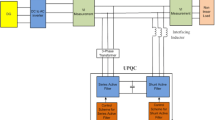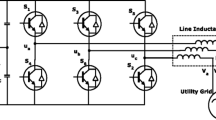Abstract
Due to concern on the environment protection, eco-friendly technology is developed in different kinds of delicate and micro-scale non-conventional energy sources in our everyday life. In this paper, the WES generates power and voltage at PCC instantaneously with the grid, which is then simulated by considering the power quality problems occurring in grid system. To mitigate power quality issues, combination of D-STATCOM and UPQC is used. The goal of this study is concerned on power quality issues, i.e., voltage/current fluctuation, flickers, harmonic caused by WES and FACTS device. In this paper, the parameters like voltage/current sag/swell are analyzed and simulated in SIMULINK/MATLAB software.
Access provided by Autonomous University of Puebla. Download conference paper PDF
Similar content being viewed by others
Keywords
- Wind energy system (WES)
- Battery energy storage system (BESS)
- Distributed static compensator (D-STATCOM)
- Unified power quality compensator (UPQC)
- Total harmonic distortion (THD)
- Point of common coupling (PCC)
- Current-controlled voltage source (CCVS)
1 Introduction
In recent days, requirement of electric power is increasing with exceeding sustainable growth and social progress, the production of electricity with renewable energy resources is more challenging task for generating systems to meet power requirements. Hence to meet the required power, non-conventional power generating systems are used. The non-conventional power resources like wind turbine, bio-fuel, water, and hybrid generating systems are used to fulfill required power for increased population growth, industrialization, and environment friendly as per the environment protection regulation guide lines [1, 2]. WES generates electricity which converts mechanical energy from wind into electricity. Induction generator is employed for run WES which is directly connected to grid. The wind energy systems present a technical challenge like instability, voltage deregulation, and power quality issues [2]. The power quality problems, i.e., current/voltage raise/drop, current/voltage disturbances, THD, imbalance, and short term voltage, which affects on the consumer instruments, cause mal-operation in their function. The more common power quality issues caused by several power electronic compensating equipments which are used for mitigation of the power quality issues, such as SVC, STATCOM, UPFC, UPQC, SSSC, etc., are used to minimize the effects caused by voltage variation [3]. In this paper, combination of D-STATCOM and UPQC is used to reduce power quality problems caused by WES connected to grid system.
2 Power Quality Problems
2.1 Voltage Variation
This is due to continuous variation of the air velocity/speed and generated torque. The variation in direct proportion to true power (P) and reactive power (Q). Voltage variation can be classified as voltage sag/dip, voltage swell/raise, voltage flicker/fluctuation, and voltage unbalance.
2.2 Harmonics
Harmonics are generated by using power electronic device and non-linear load. It should be limited to acceptable limits. Usually, it should be within 5%.
2.3 Self-excitation of WES
The self-excitation of WES with an induction generator is carried out after WES is disconnected with non-linear load. Constant voltage block connected to the induction generator hence reactive power is compensated, however by balancing of the power system frequency voltage is regulated. The cons occurring in the self-excitation are safeties, real, and reactive power balance achievement [4].
3 Analysis of Power Quality Enhancement
3.1 Power Quality Enhancement by D-STATCOM
The D-STATCOM consists of a 3-Φ VSC, and a capacitor is connected as DC link with BESS, connected at PCC. The D-STATCOM provides different magnitude and frequency component current for compensation at PCC. The D-STATCOM is based on CCVS converter that injects current into the power system or PCC so that the supply current (Is) become harmonics free and which is in-phase with source voltage. Figure 1 shown BESS with D-STATCOM [3].
3.2 Power Quality Enhancement by UPQC
The quality of power to the consumers is produced by the use of UPQC. UPQC consists of series and shunt compensators combined together which is connected via an electrical capacitor, which acts as a dc link so that the harmonic elements are within desired limits. The series element of the UPQC is known as dynamic voltage restorer (DVR) used to balance voltage level, and minimize the distortion at load side. The shunt element of UPQC is known as D-STATCOM used for load reactive power (Q) compensation; hence, source current is free from harmonic content and load is balanced. Generalized block diagram of UPQC is shown in Fig. 2.
The equation of real and reactive power of the line is,
where
- Vs:
-
Supply-side voltage.
- Vr:
-
load-side voltage.
- X:
-
System impedance.
3.3 Wind Energy System (WES)
Based on fixed speed topology with pitch control, wind turbine generates wind energy. In this scheme, the asynchronous generators are used because of simplicity and do not require field circuit separately. This can confess fixed and changing load and provide natural protection in opposition to short circuit. The obtained power generated by WES is given under Eq. 3, [2].
where
- Pout:
-
Output power in kW.
- k:
-
Constant to yield power in kW.
- Cp:
-
Maximum power coefficient.
- ρ:
-
Air density in kg/m.
- A:
-
Turbine blade area in m.
- Uwind:
-
Air speed in m/s.
4 Simulation and Result
The WES connected grid system with combination of UPQC and D-STATCOM was modeled for a non-linear load in MATLAB/SIMULATION software. The system parameter is shown in Table 1.
Figures 1, 2, and 3 show the interior structure of D-STATCOM, UPQC, and completed model of grid connected WES with UPQC and D-STATCOM, respectively. In this model, UPQC and D-STATCOM combined together with wind energy system; D-STATCOM provides compensation current to maintain the constant terminal voltage, elimination of harmonics, and balanced load. The D-STATCOM consists of three pairs of CCVS converter base IGBT, DC link capacitance, and AC inductance. The DC link capacitance is provided as an energy storage device to provide reactive power compensation. Whereas UPQC consisting of six thyristors connected altogether in each module with a dc link provided between the series and shunt filters. The UPQC provides compensated power to protect sensitive loads as well as enhances reliability of the network. Complete modeling of grid connected WES by using UPQC and D-STATCOM is shown in Fig. 3 (Figs. 4, 5, 6 and 7).
5 Conclusion
This paper presents the WES, D-STATCOM, and UPQC with filter and non-linear load connected at PCC. Due to integration of WES, power quality problems exist and connecting non-linear load total harmonic distortion (THD) occurs in the system. Power quality problems like sag, swell, fluctuation, and flicker are mitigated by using D-STATCOM and UPQC with filter. Without D-STATCOM and UPQC, load current THD is 30.02% and then with D-STATCOM and UPQC, THD has been reduced to 0.90%.
References
S. Mohamm, Power quality improvement using a novel D-STATCOM-control scheme for linear and non-linear loads, in ICEEOT (2016)
M. Patel, Power quality improvement using D-STATCOM. Int. J. Electr. Eng. 3(5) (2016)
P.R. Kasari, M. Paul, B. Das, A. Chakraborti, Analysis of D-STATCOM for power quality enhancement in distribution network, in Proceeding of the 2017 IEEE Region 10 Conference (TENCON), Malaysia (2017)
S. Karare, V.M. Harne, Modelling and simulation of improved operation of D-STATCOM in distribution system for power quality improvement using MATLAB simulink tool, in ICECA (2017)
Author information
Authors and Affiliations
Editor information
Editors and Affiliations
Rights and permissions
Copyright information
© 2020 Springer Nature Singapore Pte Ltd.
About this paper
Cite this paper
Sumithra, M., Sujatha, B.C. (2020). Enhancement of Power Quality by the Combination of D-STATCOM and UPQC in Grid Connected to Wind Turbine System. In: Saini, H., Srinivas, T., Vinod Kumar, D., Chandragupta Mauryan, K. (eds) Innovations in Electrical and Electronics Engineering. Lecture Notes in Electrical Engineering, vol 626. Springer, Singapore. https://doi.org/10.1007/978-981-15-2256-7_17
Download citation
DOI: https://doi.org/10.1007/978-981-15-2256-7_17
Published:
Publisher Name: Springer, Singapore
Print ISBN: 978-981-15-2255-0
Online ISBN: 978-981-15-2256-7
eBook Packages: EngineeringEngineering (R0)











